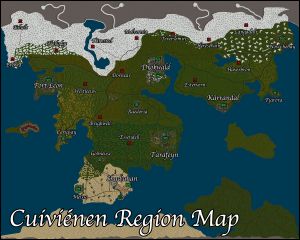Bem-vindo aos nossos novos jogadores brasileiros. Por favor leia
Difference between revisions of "Population & Land Mass"
From Sanctuary Shard
MamaWillow (talk | contribs) |
MamaWillow (talk | contribs) (→Population) |
||
| (13 intermediate revisions by 2 users not shown) | |||
| Line 1: | Line 1: | ||
| − | ''Like most games the actual size of the map is smaller | + | ''Like most games, the actual size of the map is smaller than the fictional size of the map. This page will detail the comparative values of actual map size to fictional map size. <includeonly>[[Population & Land Mass |Read More ..]]</includeonly><noinclude>[[category:Lore]][[category:RPCSS]][[image:podcast.jpg|right|150px|link=Pod Classes]] |
=Actual Map Size= | =Actual Map Size= | ||
| − | The main world map on Sanctuary is 6144 tiles by 4096 tiles. Assuming each tile is 3 feet, the actual map is 3.5 miles across by 2.3 miles tall. This is obviously not large enough to literally sustain the type of population we need for the story line conflict. | + | The main world map on Sanctuary is 6144 tiles by 4096 tiles. Assuming each tile is 3 feet, the actual map is 3.5 miles across by 2.3 miles tall. This is obviously not large enough to literally sustain the type of medieval population we need for the story line conflict. |
| − | ''Luckily, gamers are | + | ''Luckily, gamers are used to having a smaller actual map than their impression of the fictional world, and the largest of the UO world maps is rather large; so let's continue on. |
| + | |||
| + | [[image:RPCSSmap.jpg|300px|right]] | ||
=Population Centers= | =Population Centers= | ||
There are 5 major population centers with a large castle, one in each kingdom. There are 20 more strongholds (aka fiefdoms, holdfasts, fortified manor house or forts) on the map, approximately 4 per kingdom. These strongholds are the land based locations for the rest of the noble houses. Then there is another few dozen of small villages scattered around the world. | There are 5 major population centers with a large castle, one in each kingdom. There are 20 more strongholds (aka fiefdoms, holdfasts, fortified manor house or forts) on the map, approximately 4 per kingdom. These strongholds are the land based locations for the rest of the noble houses. Then there is another few dozen of small villages scattered around the world. | ||
| − | ''The game | + | ''The game currently has 5 capitals each with a castle, 1 castle in the far northeast, 17 independent strongholds, and 2 villages. The average stronghold ranges from 40x40 to 100x100 tiles. The villages are slightly larger but their main manor houses are smaller. |
=Hex Map Setup= | =Hex Map Setup= | ||
| Line 17: | Line 19: | ||
=Population= | =Population= | ||
| − | + | <font color="red">May 8th, 2020: This number was dropped</font> | |
| + | |||
| + | An estate is assumed to reasonably control the hex of their stronghold, and 6 more around it. The maximum any house can control is 10 hexes. The average population of a settled hex is about 500 people, the population of the capital is higher per. This means that an estate is responsible for approximately 5,000 people living on their land even if that is only represented by a handful of in-game villages. | ||
=Army Unit= | =Army Unit= | ||
| − | A single army unit is based on 100 men. Armies can hold up to 4 units of men, and the largest | + | A single army unit is based on 100 men. Armies can hold up to 4 units of men, and the largest estates can field 1900 men. If all 5 estates in a kingdom are united in combat, a kingdom has just under 10,000 armed forces. This is perfectly reasonable for the early Middle Ages. |
=Travel= | =Travel= | ||
| − | An army can travel just over 10 miles in a day, or exactly | + | An army can travel just over 10 miles in a day, or exactly 7 tiles in a week in RPCSS. |
Latest revision as of 20:09, 8 May 2020
Like most games, the actual size of the map is smaller than the fictional size of the map. This page will detail the comparative values of actual map size to fictional map size.
Actual Map Size
The main world map on Sanctuary is 6144 tiles by 4096 tiles. Assuming each tile is 3 feet, the actual map is 3.5 miles across by 2.3 miles tall. This is obviously not large enough to literally sustain the type of medieval population we need for the story line conflict.
Luckily, gamers are used to having a smaller actual map than their impression of the fictional world, and the largest of the UO world maps is rather large; so let's continue on.
Population Centers
There are 5 major population centers with a large castle, one in each kingdom. There are 20 more strongholds (aka fiefdoms, holdfasts, fortified manor house or forts) on the map, approximately 4 per kingdom. These strongholds are the land based locations for the rest of the noble houses. Then there is another few dozen of small villages scattered around the world.
The game currently has 5 capitals each with a castle, 1 castle in the far northeast, 17 independent strongholds, and 2 villages. The average stronghold ranges from 40x40 to 100x100 tiles. The villages are slightly larger but their main manor houses are smaller.
Hex Map Setup
The hexes, as seen in RPCSS, are approximately 128 tiles across and 112 tiles tall. This makes a hex actually less then a tenth of a mile across. A hex will completely contain a village or stronghold, and 3-6 tiles can hold each of the 5 capitals.
Fictionally we are saying that a hex is 10 miles across, or rather a 10 mile travel from the center of one hex to the center of another hex ... approximately. This makes the map 48 miles across and 36.5 miles top to bottom, still not terribly large, but given a high population density, good enough.
Population
May 8th, 2020: This number was dropped
An estate is assumed to reasonably control the hex of their stronghold, and 6 more around it. The maximum any house can control is 10 hexes. The average population of a settled hex is about 500 people, the population of the capital is higher per. This means that an estate is responsible for approximately 5,000 people living on their land even if that is only represented by a handful of in-game villages.
Army Unit
A single army unit is based on 100 men. Armies can hold up to 4 units of men, and the largest estates can field 1900 men. If all 5 estates in a kingdom are united in combat, a kingdom has just under 10,000 armed forces. This is perfectly reasonable for the early Middle Ages.
Travel
An army can travel just over 10 miles in a day, or exactly 7 tiles in a week in RPCSS.

